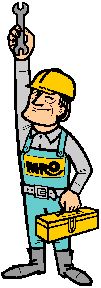
Use your head and your hands when caught without measuring instruments
Problem: When I'm out in the far reaches of the plant, I don't always have all my diagnostic tools with me. Is there an easy way to carry everything I need every time?Solution: Aside from carrying a v...
November 1, 2001 | By MRO Magazine

Problem: When I’m out in the far reaches of the plant, I don’t always have all my diagnostic tools with me. Is there an easy way to carry everything I need every time?
Solution: Aside from carrying a very heavy toolbox, it’s unlikely you can have all the tools you need with you every time you have to handle a PM task or breakdown on the spot. But every one of us owns a great set of maintenance tools that we probably use every day on the job, but don’t give the respect they deserve. Those tools are simply our senses, which enable us to learn about a machine’s condition through sight, sound, smell and touch (but probably not taste).
In fact, you can get basic readings of problems with temperature, heat flow, vibration, alignment, weight, corrosion, flow, leakage, tension, contamination or burnout, without a single tool.
That’s why it is important to try to increase awareness of your senses and pay more attention to your intuitive observations, which you may have become blas about. It’s easy to ignore certain messages you receive when your mind is full of thoughts about problems to solve and jobs to do. Yet sometimes the answer you need is right under your nose, so to speak, and the cause of a problem can be determined with your head and your hands, even when the toolbox is locked up.
However, there are a few helpful tricks to using your senses to detect changes in equipment. For example, to compare the appearance of oil this week to its colour last week, a sample could be kept in a small vial and labelled, or a colour photo — say a quick Polaroid print — would make a useful reference. Another idea is to make notes each time you check your equipment, say of the feel of the temperature on your hand, or the sensation of vibration, then refer back to them with each inspection so you can remember how the equipment used to look, feel, smell or sound the last time it was checked.
You could also save damaged components such as bearings or seals, and hang them near the equipment for future reference, as a visual reminder about what could be wrong when machinery fails, or behaves out of the ordinary.
So remember, as you walk around the plant without a complete tool kit, you can still make basic routine inspections using your own sensors. It’s probably something you do naturally, but by focusing more attention on your senses and reactions, you’ll enhance your troubleshooting expertise.
Mr. O, the Practical Problem Solver, welcomes your tips, shortcuts, advice and suggestions for solving common equipment maintenance problems. Send them anytime of year, as you develop them or as they come to mind. However, your suggestions should not bend any standards or rules, particularly regarding health and safety matters.
Do you have a solution for a maintenance problem? Send it in and if it’s published, we’ll send you a free Mr. O Problem Solver T-shirt and $35.00. Include your address and telephone number, print complete details, and add a sketch to help explain your tip. Send your ideas to Mr. O, Machinery & Equipment MRO, 1450 Don Mills Rd., Don Mills, Ont. M3B 2X7.
